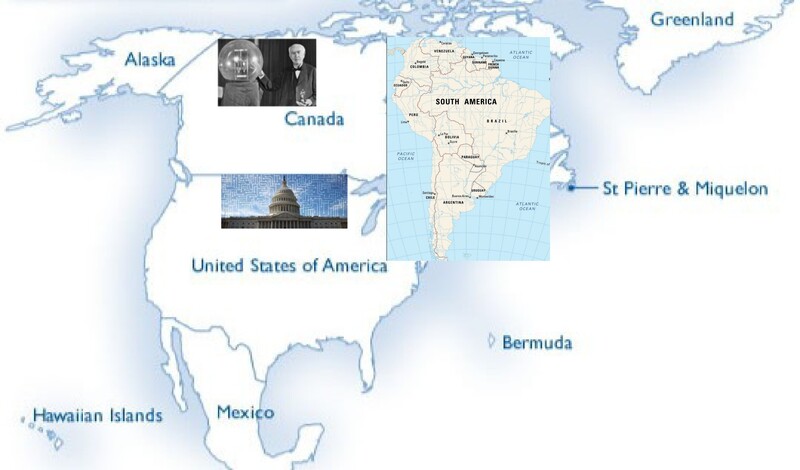 A map of North America with an inset map of South America with a focus on Innovation. Photo Credits: Pixabay
A map of North America with an inset map of South America with a focus on Innovation. Photo Credits: Pixabay
Reimagining Innovation And Technology In America: From Silicon Valley To Santiago
America has long been a cradle of innovation. Notable past inventions include the electric light bulb (1879) by Thomas Edison, which revolutionized modern-day lighting; the airplane (1903) by the Wright brothers, which transformed global travel; the digital computer (1937) by George Stibitz, contributing to the digital age; the Internet Protocol (IP) (1970s) by Vinton Cerf and Bob Kahn, leading to today's internet; and the Global Positioning System (GPS) (1994), developed by the U.S. Air Force and Department of Defense, now essential for global navigation.
Entrepreneurial Hubs Driving Transformation
Entrepreneurs, scientists, and business leaders across bustling metropolises like New York, São Paulo, Toronto, Buenos Aires, and Mexico City are shaping the future with groundbreaking ideas and transformative solutions.
Silicon Valley and Beyond: Tech Giants and Startups
From the tech giants of Silicon Valley to the rapidly growing startup ecosystems in Latin America, the Americas have established themselves as a global force in innovation. Companies like Apple, MercadoLibre, Nubank, and Shopify are redefining industries, while AI research labs (Google AI, Vector Institute, LG AI Research Centers, Microlit AI Research Centre), fintech disruptors (Stripe, Plaid, Robinhood, Dailypay, Parafin, Nubank, Creditas, Kavak, Ualá, Konfío), and biotech pioneers (Genentech, Amgen, Gilead Sciences, Biogen, CRISPR Therapeutics, Bioceres, Instituto Butantan, Tecpar, Biomanas, Grupo Insud) push the boundaries of what’s possible.
Fintech, AI, and Biotech: Pushing Boundaries
These sectors are leading the charge in transforming how we live and work. Fintech startups are making banking more inclusive, AI labs are advancing machine learning and automation, and biotech firms are tackling critical health and agricultural challenges.
Government Initiatives and Educational Powerhouses
One of the driving forces behind this innovation is the region’s entrepreneurial spirit, supported by strategic government initiatives such as:
Entrepreneurial Hubs Driving Transformation
Entrepreneurs, scientists, and business leaders across bustling metropolises like New York, São Paulo, Toronto, Buenos Aires, and Mexico City are shaping the future with groundbreaking ideas and transformative solutions.
Silicon Valley and Beyond: Tech Giants and Startups
From the tech giants of Silicon Valley to the rapidly growing startup ecosystems in Latin America, the Americas have established themselves as a global force in innovation. Companies like Apple, MercadoLibre, Nubank, and Shopify are redefining industries, while AI research labs (Google AI, Vector Institute, LG AI Research Centers, Microlit AI Research Centre), fintech disruptors (Stripe, Plaid, Robinhood, Dailypay, Parafin, Nubank, Creditas, Kavak, Ualá, Konfío), and biotech pioneers (Genentech, Amgen, Gilead Sciences, Biogen, CRISPR Therapeutics, Bioceres, Instituto Butantan, Tecpar, Biomanas, Grupo Insud) push the boundaries of what’s possible.
Fintech, AI, and Biotech: Pushing Boundaries
These sectors are leading the charge in transforming how we live and work. Fintech startups are making banking more inclusive, AI labs are advancing machine learning and automation, and biotech firms are tackling critical health and agricultural challenges.
Government Initiatives and Educational Powerhouses
One of the driving forces behind this innovation is the region’s entrepreneurial spirit, supported by strategic government initiatives such as:
- Global Entrepreneurship Summit (GES)
- Global Innovation Through Science and Technology (GIST)
- WECREATE Centers for Women Entrepreneurs
- Presidential Ambassadors for Global Entrepreneurship (PAGE)
- National Advisory Council on Innovation and Entrepreneurship (NACIE)
Strong educational institutions such as the University of São Paulo (USP), Pontificia Universidad Católica de Chile (UC), University of Campinas (Unicamp), Stanford University, and Massachusetts Institute of Technology (MIT) are creating fertile ground for startups to thrive.
Startups Thriving in a Technology-Driven Economy
Programs like Start-up Chile, Brazil’s SoftBank Latin America Fund, and Canada’s AI research centers—Vector Institute for AI, Mila - Quebec AI Institute, and Alberta Machine Intelligence Institute (Amii)—demonstrate how the region embraces a technology-driven growth economy.
Real-World Problem Solvers: Innovation with Impact
What makes innovation in the Americas particularly unique is its focus on solving real-world problems. Fintech startups are revolutionizing banking for unbanked populations, edtech platforms are bridging educational gaps, and sustainable energy projects are tackling climate change, from wind farms in Argentina to solar initiatives in the southwestern U.S.
Smart Cities: The Future of Urban Living
Cities like Bogotá, Santiago, and Austin are becoming testing grounds for smart city technologies. These cities integrate data-driven urban planning, AI-driven transportation systems, and green infrastructure to create more habitable and sustainable environments.
Seamless Digital Economies: E-Commerce and Digital Payments
E-commerce platforms such as Amazon, eBay, Walmart, Etsy, MercadoLibre, B2W Digital, and Linio continue to grow, while digital payment services like PayPal, Venmo, PagSeguro, MercadoPago, PicPay, and Square are making cross-border business transactions more seamless than ever before.
Challenges to Innovation: Inequality, Infrastructure, and Regulation
Despite the progress, innovation in the American region is not without its challenges. Issues such as digital inequality, infrastructure limitations, and talent shortages still pose barriers. Rural areas struggle with access to funding, while regulatory hurdles slow down growth and adoption of new technologies.
Turning Barriers into Opportunities
However, these challenges also present significant opportunities. Governments, private investors, and academic institutions are increasingly working together to bridge gaps by providing funding for startups, improving digital literacy, and fostering international collaboration.
A Collaborative Future for Business and Technology
With increased cooperation, knowledge sharing, and investment, the Americas are poised to strengthen their position as a global innovation hub. A unique blend of established tech powerhouses (Apple, Facebook, IBM, Google, OLX, Glubotant, Nubank) and emerging innovators (Creditas, Savvi AI, Hohonu, Telepath, Mujin, Simplex Wireless) ensures continuous momentum.
Innovation Without Borders
As we move further into the 21st century, the American region stands at the forefront of business transformation and technological breakthroughs. The future isn't just about competition—it’s about collaboration, creativity, and resilience. Whether it’s in AI, fintech, clean energy, or e-commerce, the Americas are proving that innovation knows no borders.
Senior Editor: Kenneth Njoroge
Financial Expert/Bsc. Commerce/CPA
